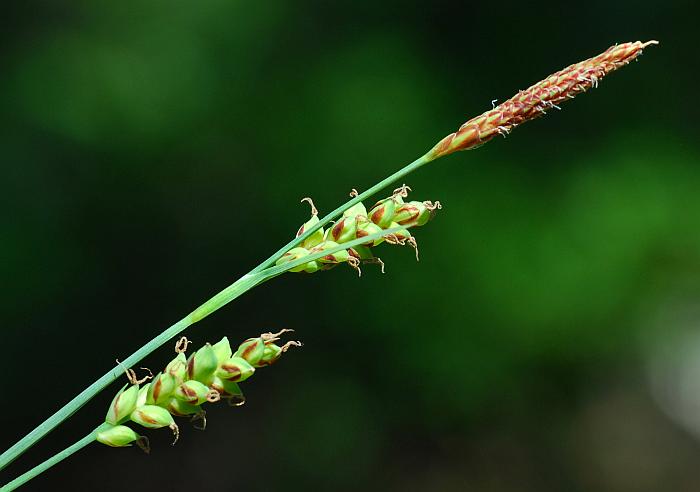Carex meadii Dewey
Mead's Sedge

Native
CC = 6
CW = 0
MOC = 70
© SRTurner
Carex meadii DeweyMead's Sedge | |
 |
Native CC = 6 CW = 0 MOC = 70 |
© SRTurner |
|
Family - Cyperaceae Habit - Monoecious sedge, with long-creeping rhizomes, forming colonies of tufts. Stems - Flowering stems to +/-40cm tall, erect, sharply 3-angled, glabrous, light bluish-green, often glaucous, typically single from the base, from creeping rhizomes.
Leaves - Alternate, sheathing, to +/-10cm long, 3-7mm broad, glabrous.
Inflorescence - Staminate spikes superior to the pistillate, to 4cm long, -5mm in diameter. Pistillate spikes on short stalks or sessile, to +/-3cm long, 5-9mm in diameter, with 8-30 fruits.
Flowers - Perigynia light green to yellowish or brownish, plump, widest above the middle (obovate), +/-4mm long, -3mm broad, with a slightly bent beak. Styles 3, withering in fruit.
Flowering - March - June. Habitat - Limestone and dolomite glades, bluffs, upland prairies, openings of dry upland forests, roadsides, railroads. Origin - Native to the U.S. Lookalikes - Other sedges. Other info. - Although this species can be found throughout much of Missouri, it is most common in the Ozark region where it is a characteristic glade and dry upland species. The plant is easy to identify because of its habitat, its light green-blue stems, and its long rhizomes. The plump, light-colored fruits are another good character to use for identification. The plant is sometimes found in more mesic areas and will grow taller and less erect than in the dry locations. Photographs taken in Eminence, MO., 5-24-03, and in the Piney Creek Wilderness, Barry County, MO., 4-4-04 (DETenaglia); also at Indian Trail Conservation Area, Dent County, MO, 5-4-2013, and Danville Conservation Area, Montgomery County, MO, 5-6-2017 (SRTurner). |